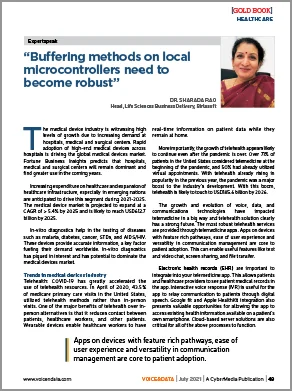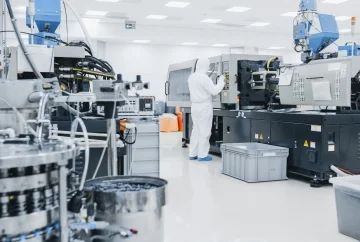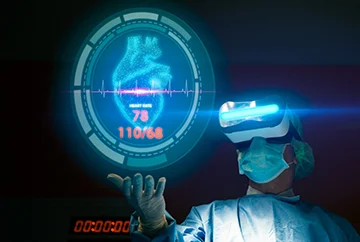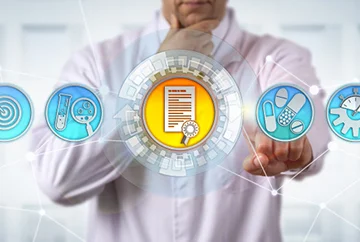To predict the risk of a disease becoming a pandemic, several threat vectors are analyzed. These include insect and animal populations, global and regional climate conditions, flight data and itineraries worldwide, capacity of health systems, and vaccine development.
When developing new vaccines, the goal is to include strongly immunogenic viral components that cause a response from the immune system. Machine learning has enabled great strides in immunology. AI can help identify viral fragments that have the properties needed to accomplish these goals, while ML enables advancements that humans would not be able to achieve otherwise.
The precision, efficiency, and speed of these developments cannot be achieved with human work alone. With machine assistance, immunologists have identified over one million fragments of proteins on a cell’s surface that are discoverable by T-cells. Thanks to ML, COVID-19 vaccine development has been implemented worldwide.
Stay Ahead
Visit our Life Sciences & Healthcare page
The internet of medical things (IoMT): Various devices and mobile apps have come to play a critical role in tracking and preventing chronic illnesses for many patients and their doctors. By combining internet of things (IoT) development with telemedicine and telehealth technologies, a new internet of medical things (IoMT) has emerged. This approach includes the use of several wearables, including ECG and EKG monitors. Many other common medical measurements can also be taken, such as skin temperature, glucose level, and blood pressure readings.
By 2025, the IoT industry will be worth USD6.2 trillion. The
healthcare industry has become so reliant on IoT technology in 2020 that 30% of the market share of these devices is expected to come from healthcare. With the arrival of new delivery methods, such as the first smart pill approved in 2017 by the FDA, practitioners will have many interesting options for providing care in a more effective manner.
AR/VR/MR in Healthcare
Augmented and virtual realities (AR/VR) are important technologies with great potential to enhance the quality of telehealth during the COVID-19 pandemic. From enhancing patient and provider visits to helping educate medical students in procedure simulations, this technology is turning science fiction into reality. AR and VR technology shows promise for helping stroke victims overcome motor deficiencies. These patients must be put in a robust environment to help regain motor control. However, simulated environments provide more flexibility that physical therapy may not be able to offer. These controlled simulations can be used to gather data to help therapists tailor care plans for their patients.
There are new products such as VR headsets to work with individuals who have concerns ranging from dementia to cognitive impairments. They have access to activities and experiences that are otherwise unavailable in their current environments. This may allow patients to unlock memories and improve their emotional well-being.
Augmented reality can greatly assist healthcare providers in providing service. Since information can be provided in 3D space in a surgeon or doctor’s vision, they can have real-time access to information that can benefit their procedures. This can allow students to learn more about procedures through overlays, and doctors can quickly compare data to help them make diagnoses. Another aspect of AR technology that is useful for the healthcare market is advancements in robotic surgeries. The future of AR will be strongly influenced by its use in healthcare settings.
Challenges Ahead
Providing consistent and effective communication with numerous medical IoT devices is one of the biggest challenges that the sector faces.
Manufacturers still regularly utilize their own proprietary protocols for talking to devices. This can present problems, especially when trying to collect large amounts of data by servers.
Connectivity issues are also still common, as the collection of data by microcontrollers and smartphones can be disrupted by several factors in the environment. Buffering methods on local microcontrollers need to become more robust to maintain better connections.
Potential security concerns also need to be addressed, as indicated by a report from the Ponemon Institute’s Sixth Annual Benchmark Study on Privacy and Security of Healthcare Data, which showed that 89% of healthcare operations had been the subjects of at least one data breach.
The Privacy Issues
Privacy is an extremely important issue in health technology, especially with regards to HIPAA compliance in 2020. Although cloud computing can make storing and retrieving data more efficient, regulations to secure electronic protected health information (ePHI) are very strict and complying with them can be very difficult.
Remote communication with patients is especially important during the COVID-19 public health emergency. Some telehealth technologies are not fully compliant with HIPAA which can raise challenges for patient privacy. Healthcare providers should ensure that they are still following the regulations as best as they can, only missing the bar where they have to.
Future Outlook Post COVID
As the world completes a year of the pandemic, many countries have resumed daily life and a lot of them have forced down lockdowns to combat the rising number of cases. Despite vaccines being rolled out, it a stark reality that the pandemic has impacted several industries, and the livelihoods associated with it. The move towards digital has found many takers and has posed a challenge to brick-and-mortar alternatives.
The speed at which technological changes have been inspired by COVID-19 has led to accelerated trends like – industrial automation and contactless payments. AR/VR, 3D printing, telehealth has given many industries a fresh lease of life during these testing times, enabling them to continue providing value to consumers and helping keep the economies running. Everything from doctors’ appointments, medical consultation to regular life went online. People were forced to indoors yet made digital an indispensable part of their lives.






